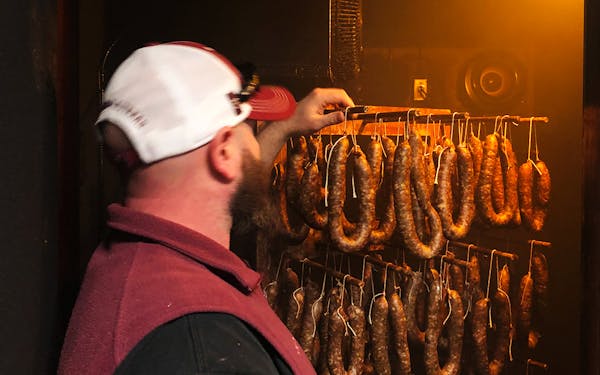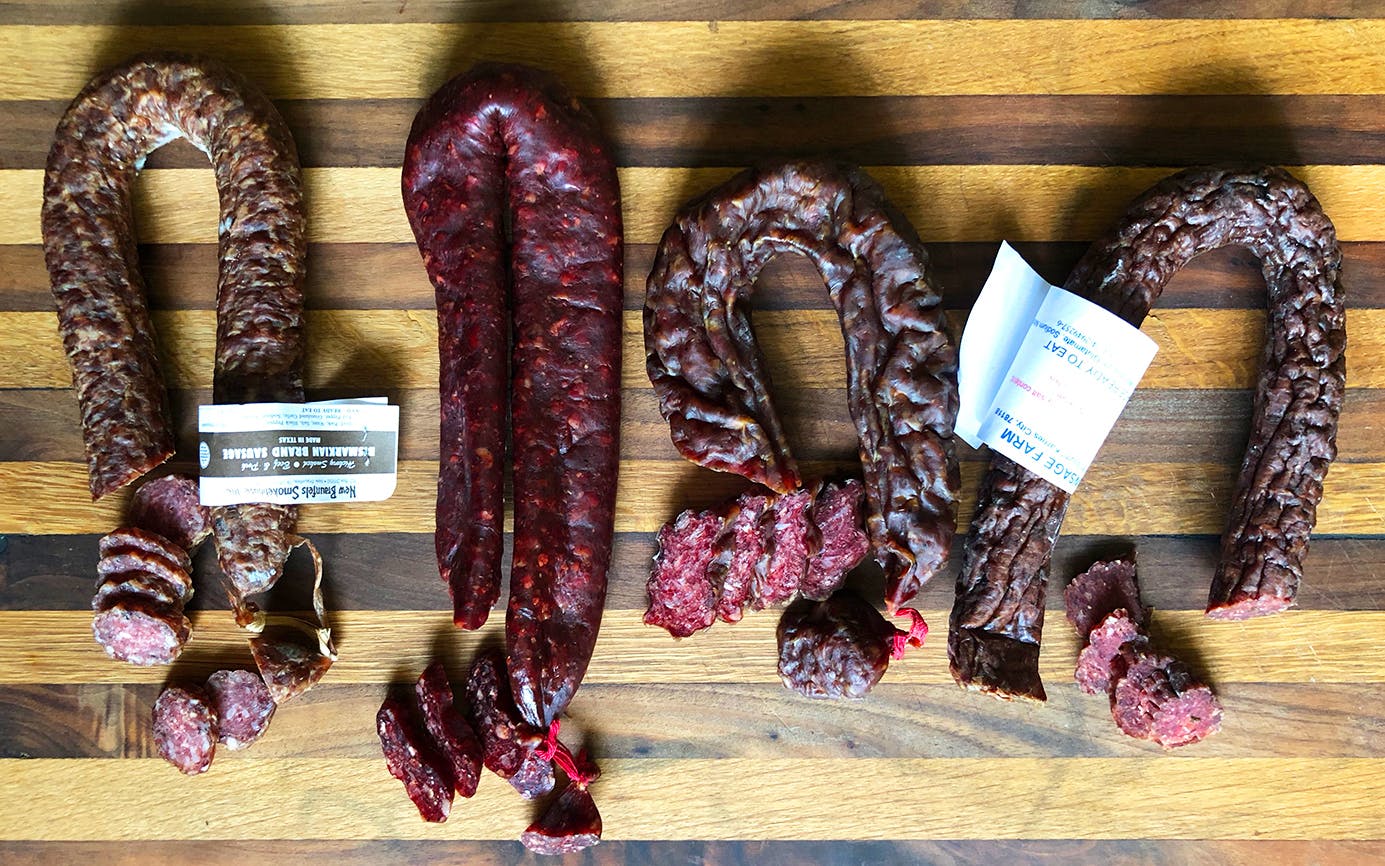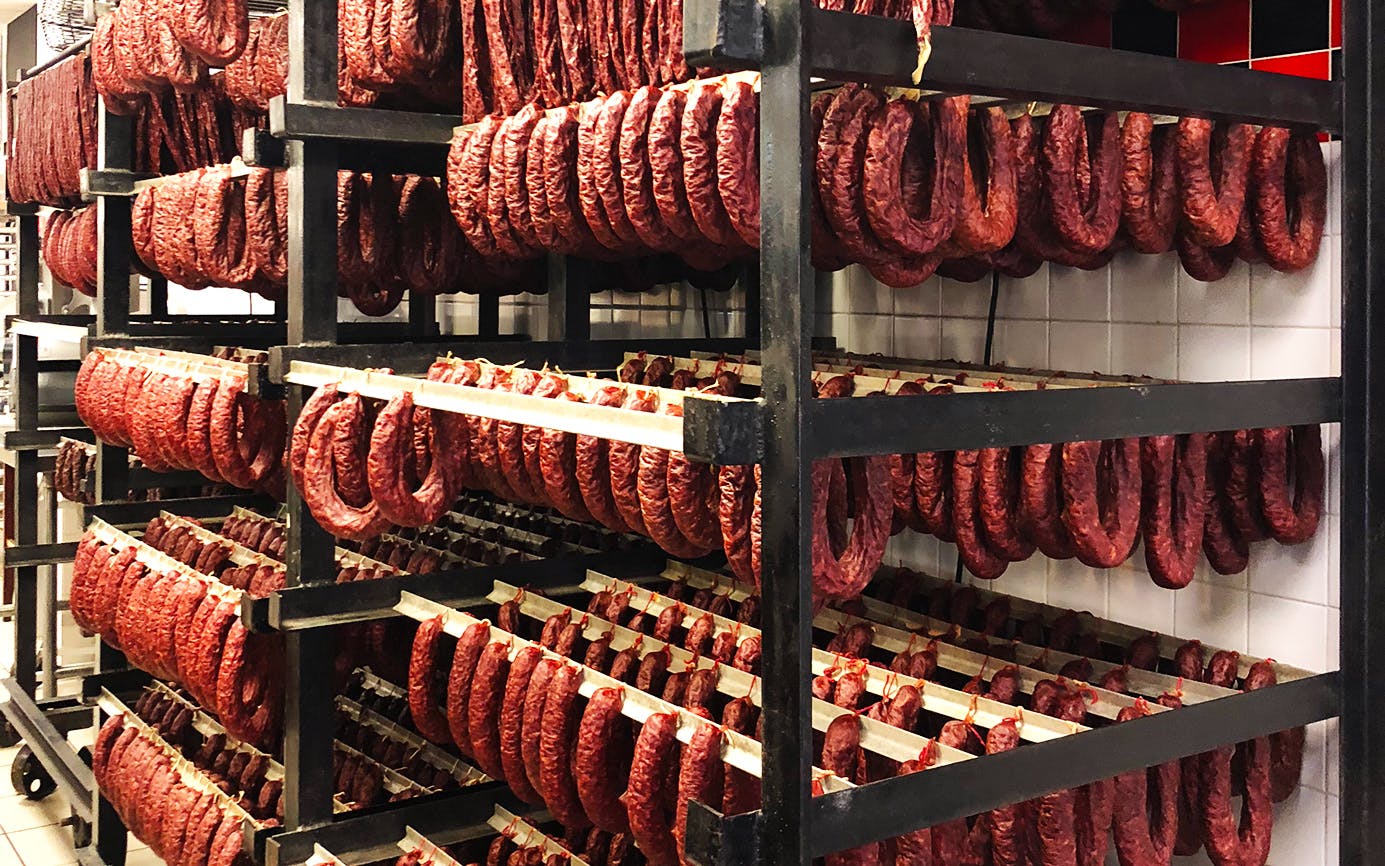Meet the masters behind this meat art form. You’ll never overlook those links hanging in your favorite market again.

Photograph by Daniel Vaughn
I did a double take at the ropes of sausage hanging over the meat counter at Granzin’s Market in New Braunfels. The parched sausages dangled from a wooden dowel like stage props. They were neither packaged nor refrigerated, but they weren’t plastic. A young man behind the counter unhooked one and handed it to me, and for just $4.79, I took home a half-pound link of dried sausage made exactly like they did it 38 years ago, when Granzin’s first opened in town.
Owner Gary Granzin explained the process to me. “We smoke it for three hours before it’s put up to dry,” he said, but he cautioned: “The key is not to dry it too fast, cause then it gets a crusty edge around it.” While a few dozen links were hanging above the counter, several hundred sat on racks at the far end of the market awaiting their optimal dryness. “It takes about a week for it to be ready to eat,” Granzin said, noting that he tests the ripeness of each batch with an unscientific squeeze test. He’s got the touch by now considering they make three thousand pounds of the stuff on a normal week and up to five tons a week during the holidays. Texans love their dried sausage. Said Granzin: “Once you try it, we’ve got you hooked.”
What is dried sausage? It’s a cased sausage that is cold-smoked and dried. It falls somewhere between jerky and salami. The links don’t require refrigeration, but they do have an expiration date. Hang them too long and they’ll become so tough as to be inedible. If your local meat market displays them on a dowel, that means the store goes through enough to cycle in the fresher batches as they are readied for sale. It has recently become my favorite portable snack.
Thank you for reading Texas Monthly
Now more than ever Texans are connecting over shared stories. Enjoy your unlimited access to our site. To have Texas Monthly magazine delivered to your home, become a subscriber today.
My first encounter with Texas dried sausage was inside Kuby’s Sausage House, in Dallas. Behind their meat case they hang landjäger, a thinner variation of dried sausage with German roots. It’s made with small lamb casings instead of pork, but it’s still cold-smoked and dried. The newly ripe, or “soft,” links are hung on the left. The further to the right you go, the drier the landjäger, but owner Karl Kuby Jr. says they rarely last longer than about four days. “It doesn’t really go bad, but it gets so hard you can’t chew it,” he explained. Much to my wife’s chagrin, I have a few links hanging from the cabinet doors at home (the kitchen has never smelled better) for easy access, and there’s an obvious difference in texture from day to day. The change isn’t as pronounced with larger versions of dried sausage made from pork casings, which is the normal style found in Texas.
At Dziuk’s Meat Market, in Castroville, they specialize in dried meats like beef jerky in strips and chunks (which is sliced before eating), and dried sausage. Jeffrey Fankel, son-in-law of founder Marvin Dziuk, helps run the place. He says that while the jerky is their most popular item, they send about nine hundred pounds of sausage into the smoker each week to become dried sausage. It loses about half of its weight during the drying process, which is a little better than jerky, which loses two-thirds of its original weight.
The process at Dziuk’s starts with racks full of sausage taking a two-hour hickory smoke bath inside an industrial smoker. The rack is then wheeled into a humidity-controlled drying room for four or five days. Then it goes back in the smokehouse for hot smoke to cook until the links reach an internal temperature of 165 degrees. This final step is rare for small-town meat markets that sell only to in-store customers, but shipping is a big part of Dziuk’s business, and the Texas Department of Health requires it. “A lot of people like their sausage naturally dried,” Fankel says, “but I have to prove that mine gets to a certain temperature for safety reasons.”
Castroville is an Alsatian town just west of San Antonio, but the Dziuk family is Polish. Their sausage recipes originated at the old family market in Poth, southeast of San Antonio, along the Polish sausage trail—my designation—of Texas Highway 181. Once in Castroville, they adapted to a new clientele with an Alsatian sausage that featured coriander. They sell their Polish recipe right alongside it, but the Alsatian is more popular. Their blend of nutmeg, cloves, allspice, and coriander also goes it into the dried sausage, providing a unique flavor. I tried the beef and pork mix, which is the standard, but Fankel recommended a newer recipe. “If you like dried sausage, you’ve gotta try the quail and pork,” he urged, sensing that he had likely secured a return visit from me.
Back in Poth, there’s still dried sausage to be found. Wiatrek’s Meat Market makes the smokiest version I’ve tried to date. I spoke to Carter Ray in their new San Antonio store. He and his dad, Tom Ray, purchased the Poth store from the Wiatrek family in 2008 and opened the new outpost last year. Dried sausage is popular in both locations, but they make it all in an old mesquite-field smokehouse behind the store in Poth. “We have a true firebox in there,” Carter Ray said, explaining, “We were grandfathered into that process.” Which is why they can’t sell their sausage through other retailers.
While most of the other dried sausages I tried take at least a week to finish, Wiatrek’s gets theirs done in about four days. They make it early in the morning in hundred-pound batches. The sausages hang on wooden dowels in the smokehouse for eight hours, then go back into the cooler overnight. The next day they return to the smoker for another eight hours before hanging to dry for a day. At that point, they’re ready to sell. “There’s a little shorter shelf life than most dried sausages because we don’t use all the junk you can put in there to extend shelf life,” Ray told me. I think the shorter shelf life also has to do with their short drying time. I hung one at my house and ate off of it for a few days. The link got little tighter and more to my liking. It also puts off quite a perfume, which isn’t lost on Ray, who likes to travel with a link. “My truck always has that faint mesquite smell.”
The recipe at Wiatrek’s came from the original owner. “It’s a Polish-style sausage, so it has garlic,” Ray said. They grind it twice to get a finer texture than their fresh sausages, so it dries more quickly. The key is to use a mix of fatty pork—most people I talked to use the pork shoulder—and very lean beef. A good swap for the lean beef is venison; the dried sausage is popular with deer hunters who bring their harvest into Wiatrek’s for processing. “Some of them say, ‘Just give me the backstraps and make the rest into dried sausage,'” Ray told me.
It’s a great feeling every time I see a dried sausage on offer in a meat market. I know the owners are carrying on a tradition that isn’t quite as celebrated as beef jerky. Most dried-sausage makers I encountered (and there are many more than are mentioned in this article), are proud to be using old family recipes or ones passed down from long ago. There aren’t many folks looking to break new ground in the dried-sausage game, but I found a market in Thorndale that’s pushing the boundaries of the genre.

Frank Felton III, who goes by Trey, has run Thorndale Meat Market since 2011, taking over from his grandfather Marvin Rodenbeck. Inside Thorndale Meat Market you’ll find dried sausage hanging from just about every column in sight. Think far beyond original and spicy flavors. Felton has dreamed up recipes for over a dozen dried sausages, including bulgogi, chorizo, and Cajun versions, which I was lucky enough to sample, as well as a pecan and apple variety that I’ll have to look for on my next visit. It’s far more than Rodenbeck ever imagined coming out of his old market, so Felton and I went to visit him to see what he thought of his grandson’s experimental sausages.
“You brought me some one time, but I’m not sure if I used it or not,” Rodenbeck confessed to his grandson as we sat at in his home. Whereas some people have a media room or a woodworking shop, Rodenbeck has a sausage-making shed on his property. He gave up the meat market business but still makes and sells two-hundred-pound batches of dried sausage about once every couple weeks during the winter. He employs the same spice mix his dad used for fresh sausage, but it was his wife, Millie—she passed away in 2014—who developed the method for turning it into dried sausage. “She worked that recipe. Trial and error,” Rodenbeck said.
He smokes it in a huge steel cylinder in the yard. There’s a center pole that the receives the dowels from which the sausages hang. A series of gears and a motor turn it slowly, one revolution every fifteen minutes, as he feeds post oak (he likes round logs with the bark) into the remote firebox. The sausage stays in the smoker for a couple of days before it hangs inside the shop. “I walk by it every day, and I mash on one of the sausages,” Rodenbeck says. “If it’s got a little spongy to it, you’ve gotta leave it hanging a little longer. There are no gauges.” The links are usually ready to slice into after two weeks. The final product is subtly flavored with smoke and spice. There’s nothing overpowering, and the coarse grind leaves plenty of air pockets that give it a tender texture.
In contrast, his grandson’s dried sausages at Thorndale are full of bold flavors. He adds honey and turbinado sugar to the mix, and the sweetness plays well against the heat of the peppers and seasoning in the chorizo. The green onions are a pleasant and surprising addition to the Cajun dried sausage. All of the half dozen flavors I sampled were on the smokier side. Felton rigged a walk-in cooler to act as his cold smoker. It hovers in the mid-seventies while oak smoke is pumped in via a long steel tube attached to the remote firebox. The sausages stay in the smoke-filled cooler for a solid three days before hanging to dry for another week, give or take a few days.
Felton uses a tried and true fifty-fifty mix of pork and beef. “If you use all pork, it will take like three weeks to dry out,” he explains. “If you use all beef, it will dry so hard it’ll be like chewing through jerky.” He’s had many successes, but some failures too, like his attempts to make pepperoni or when he added beef fat into the mix. “You can’t use any beef fat,” he warned, or “it’ll go rancid.” Unlike most dried-sausage makers who use a curing agent, Felton instead grinds raw celery right into his mix, which acts as a natural preservative. He also credits the high salt content, which does most of the heavy lifting when it comes to dehydration.
Whether or not his grandfather can muster praise for Felton’s dried sausage, he applauds what Felton is trying to do. Felton has transformed this old-style recipe, that otherwise would be preserved in amber, and he’s finding ways to push it into new territory that bring in a new generation of fans who appreciate the art of dried sausage. “There’s so much more you can do with it,” Felton said, but he’s aware of his place in the family sausage lineage. “Carrying on that legacy was first in my mind,” he told me. It think it is precisely Felton’s willingness to offer unique varieties that appeal to new customers that will allow his beloved tradition to thrive rather than just survive.

A rack of dried sausages at Granzin’s Meat Market in New Braunfels.
Photograph by Daniel Vaughn
For great dried sausage:
Granzin’s Meat Market in New Braunfels (they offer shipping)
Kuby’s Sausage House in Dallas (for landjaeger)
Dzuik’s Meat Market in Castroville (they offer shipping)
Wiatrek’s Meat Market in Poth and San Antonio
Thorndale Meat Market in Thorndale
I’ve also enjoyed the dried sausages at Elder’s Country Store in Beeville, Klein Smokehouse in Boerne, Meyer’s Elgin Smokehouse in Elgin, New Braunfels Smokehouse in New Braunfels, Pollock’s in Falls City, Sklenarik’s Smoked Meats in Miles, Vincek’s in East Bernard, and Buc-ee’s carries a pretty good version of venison and pork dried sausage at all their stores. Both Gary Granzin and Carter Ray mentioned how much they liked Penshorn Meat Market in Marion.
- Daniel Vaughn for texasmonthly.com | February 1, 2019